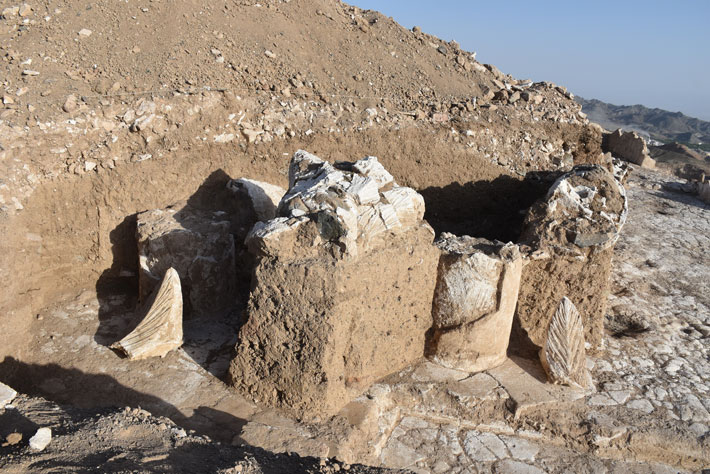Archaeologists unearth ‘great’ Sassanid fire temple in northeast Iran

“We have probably discovered the third greatest fire temple that existed in ancient Iran,” ILNA quoted archaeologist Meysam Labbaf-Khaniki as saying on Wednesday.
Labbaf-Khaniki leads the fifth season of an areological survey, which is currently underway in a valley near the village of Robat-e Sefid/Bazeh Hur, northeast Iran.
“During this archaeological season, we have gathered considerable evidence such as engraved plasterwork and inscriptions that suggest the ruins are related to an important fire temple.”
Inscriptions and their fragments that bear Pahlavi scripts should first be arranged and categorized till they could be read (and deciphered) by linguists and cultural heritage experts, he explained.
These fresh discoveries are expected to open a new chapter in the history of Iranian arts during the Sassanid epoch, the archaeologist said.
Exquisite stuccoworks embellish capital columns that support the main hall of the fire temple, he said.
Since 2014, Labbaf-Khaniki has taken part in previous excavations conducted at the ancient site. In 2018, a joint Franco-Iranian mission was tasked to study the whole valley, its human occupations, its geomorphology, and its implication in the large territory of Khorasan Razavi province.
The Sassanid age is of very high importance in the history of Iran. Under Sassanids, Persian architecture in addition to arts experienced a general renaissance.
Architecture often took grandiose proportions such as palaces at Ctesiphon, Firuzabad, and Sarvestan which are amongst the highlights of the ensemble.
Sassanid archaeological designs typically represent a highly efficient system of land use and strategic utilization of natural topography in the creation of the earliest cultural centres of the Sassanid civilization.
READ ALSO: PRESERVED BY NATURE: STUDYING THE SPECTACULAR SALT MUMMIES OF IRAN
In 2018, an ensemble of Sassanian historical cities in southern Iran, titled “Sassanid Archaeological Landscape of Fars Region”, was named a UNESCO site. The ensemble is comprised of eight archaeological sites situated in three geographical parts of Firuzabad, Bishapur, and Sarvestan.
The World Heritage reflects the optimized utilization of natural topography and bears witness to the influence of Achaemenid and Parthian cultural traditions and of Roman art, which later had a significant impact on the architecture and artistic styles of the Islamic era.
Aside from architecture, crafts such as metalwork and gem-engraving grew highly sophisticated, yet scholarship was encouraged by the state. In those years, works from both the East and West were translated into Pahlavi, the language of the Sassanians.
